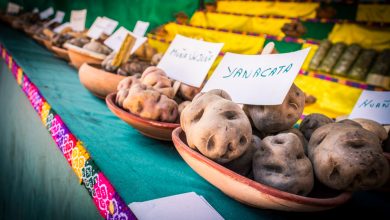Uncucha, A Healthy and Tasty Treasure

The uncucha (Xanthosoma sagittifolium) is a well known tuber that is consumed in many parts of the world, as well as in Cusco. The word we call it is just one of many. It is also called yautía, malanga, macal, quicamote, okomu, and more. In Cusco, though, it goes by uncucha. Even if not as famous as the potato people know its benefits and seek it out.
Filled with vitamins and health benefits, the uncucha comes to us from Quillabamba in Cusco’s La Convención province. It is grown there and in tropical valley close by. This wonderful tuber arrives in the Imperial City from September through April. The trucks transporting it arrive every morning at 5 am. From there, the vendors buy or obtain merchandise and take it to all the different markets of the city, including San Pedro, Cascaparo, Wanchac, and Ttio.

Books from Amazon you might wish to look at.
I. Roth and Helga Lindorf
South American Medicinal Plants: Botany, Remedial Properties and General Use (Springer, 2002)

Vincent Lebot
Tropical Root and Tuber Crops: 17 (Crop Production Science in Horticulture)(CABI, 2008)

I like the flavor of uncucha a lot. Its brown peel with stripes takes me to coffee time in Quillabamba, a pause for a few moments during the day whether you are just beginning it or to take pleasure at other hours. The climate there is warm and the air humid. In the afternoon when the sun departs it is wonderful to eat boiled uncucha along with a cup of good coffee from La Convención. All year long uncucha is sold in the markets of that city.
In Cusco you can also find uncucha in boiled form on our streets beginning around ten am. It is sold on Pera and Calle Nueva Streets as well as around the markets. You will see the vendors with cloths and shawls covering their pots so they do not lose their heat. The offer uncucha on throw-away plates. Each portion consisting of five pieces costs 2/S.
In the markets you can buy raw uncucha for 3.50/S a kilo.
People pause in their activities while walking through the city to have some uncucha or they take it home for their refreshment in the afternoon. They will have it with some salad of lettuce, tomato, and onion and with a cup of coffee. Most people know the wonderful taste and nutritious value of the uncucha.
One time I was in Arequipa, a city at some distance from Cusco here in the Peruvian south. I was visiting one of its markets and enjoyed seeing uncucha presented in the tuber section. Suddenly, I just wanted to eat some boiled uncucha just like they sell it in Cusco. I walked around the market a couple of times and could find no one selling it that way.
I did not want to just be stuck with frustrated desires. I had to try it so I told myself, “It must be part of some menu here in the restaurants.” By asking directions I found myself deep inside the market, in the food section. They offered a great variety of dishes. A board listed the fixed menu as squash crème with uncucha. I did not hesitate and sat to enjoy this offering.
As a first course the casera (vendor) served me a bowl of semola soup with crunch French fried potatoes scattered on it. It was light and tasty. As a main dish I got the crème of squash with uncucha. The casera dished it up and it looked appetizing and creamy. Amidst the bright color of the squash the uncucha danced white and soft in cubes. It was tasty. The combination of squash and rice? Wow. I loved it.
I ended up content and satisfied. While the casera was serving me my soft drink (refresco) I asked her where the uncucha came from. She said, “From the jungle of Manu and from Tambopata.”
To taste some boiled uncuchas is a true delight at any time or any place. You can cook them, however, in other ways. That is where they imagination and skill of the cook or chef can shine.




